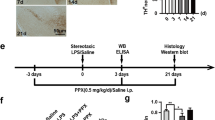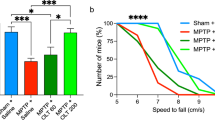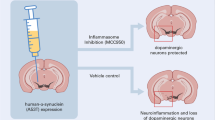Abstract
Recent researches showed that nucleotide-binding domain and leucine-rich repeat protein 3 (NLRP3) inflammasome inhibition exerted dopaminergic neuroprotection in cellular or animal models of Parkinson’s disease (PD). NLRP3 inflammasome has been proposed as a drug target for treatment of PD. However, the interplay between chronic NLRP3 inflammasome and progressive α-synuclein pathology keeps poorly understood. Moreover, the potential mechanism keeps unknown. In the present study, we investigate whether NLRP3 inflammasome inhibition prevents α-synuclein pathology by relieving autophagy dysfunction in the chronic 1-methyl-4-phenyl-1, 2, 3, 6-tetrahydropyridine (MPTP) mouse model of PD. NLRP3 knockout mice and their wild-type counterparts were treated with continuous MPTP administration via osmotic mini-pumps. Dopaminergic neuronal degeneration was assessed by western blotting and immunohistochemistry (IHC). The levels of dopamine and its metabolites were determined using high-performance liquid chromatography. NLRP3 inflammasome activation and autophagy biomarkers were assessed by western blot. The expressions of pro-inflammatory cytokines were measured by ELISA. The glial reaction and α-synuclein pathology were assessed by IHC and immunofluorescence. Our results show that NLRP3 inflammasome inhibition via NLRP3 knockout not only protects against nigral dopaminergic degeneration and striatal dopamine deletion but also prevents nigral pathological α-synuclein formation in PD mice. Furthermore, it significantly suppresses MPTP-induced glial reaction accompanied by the secretion of pro-inflammatory cytokines in the midbrain of mice. Most importantly, it relieves autophagy dysfunction in the midbrain of PD mice. Collectively, we demonstrate for the first time that improving autophagy function is involved in the preventive effect of NLRP3 inflammasome inhibition on α-synuclein pathology in PD.






Similar content being viewed by others
References
Hirsch EC, Vyas S, Hunot S (2012) Neuroinflammation in Parkinson's disease. Parkinsonism Relat Disord 18(Suppl 1):S210–S212
Heneka MT, McManus RM, Latz E (2018) Inflammasome signalling in brain function and neurodegenerative disease. Nat Rev Neurosci 19(10):610–621
Gordon R, Albornoz EA, Christie DC et al (2018) Inflammasome inhibition prevents α-synuclein pathology and dopaminergic neurodegeneration in mice. Sci Transl Med 10(465):eaah4066
Mao Z, Liu C, Ji S, Yang Q, Ye H, Han H, Xue Z (2017) The NLRP3 Inflammasome is involved in the pathogenesis of Parkinson's disease in rats. Neurochem Res 42(4):1104–1115
Sarkar S, Malovic E, Harishchandra DS, Ghaisas S, Panicker N, Charli A, Palanisamy BN, Rokad D et al (2017) Mitochondrial impairment in microglia amplifies NLRP3 inflammasome proinflammatory signaling in cell culture and animal models of Parkinson's disease. NPJ Parkinsons Dis 3:30
Lee E, Hwang I, Park S, Hong S, Hwang B, Cho Y, Son J, Yu JW (2019) MPTP-driven NLRP3 inflammasome activation in microglia plays a central role in dopaminergic neurodegeneration. Cell Death Differ 26(2):213–228
Yan Y, Jiang W, Liu L, Wang X, Ding C, Tian Z, Zhou R (2015) Dopamine controls systemic inflammation through inhibition of NLRP3 inflammasome. Cell. 160(1–2):62–73
Han X, Sun S, Sun Y, Song Q, Zhu J, Song N, Chen M, Sun T et al (2019) Small molecule-driven NLRP3 inflammation inhibition via interplay between ubiquitination and autophagy: Implications for Parkinson disease. Autophagy. 15(11):1860–1881
Hou X, Watzlawik JO, Fiesel FC, Springer W (2020) Autophagy in Parkinson’s disease. J Mol Biol 432(8):2651–2672
Martins JD, Liberal J, Silva A, Ferreira I, Neves BM, Cruz MT (2015) Autophagy and inflammasome interplay. DNA Cell Biol 34(4):274–281
Fornai F, Schlüter OM, Lenzi P et al (2005) Parkinson-like syndrome induced by continuous MPTP infusion: Convergent roles of the ubiquitin-proteasome system and alpha-synuclein. Proc Natl Acad Sci U S A 102(9):3413–3418
Gibrat C, Saint-Pierre M, Bousquet M, Lévesque D, Rouillard C, Cicchetti F (2009) Differences between subacute and chronic MPTP mice models: Investigation of dopaminergic neuronal degeneration and alpha-synuclein inclusions. J Neurochem 109(5):1469–1482
Wu KC, Liou HH, Lee CY, Lin CJ (2019) Down-regulation of natural resistance-associated macrophage protein-1 (Nramp1) is associated with 1-methyl-4-phenyl-1,2,3,6-tetrahydropyridine (MPTP)/1-methyl-4-phenylpyridinium (MPP(+) )-induced alpha-synuclein accumulation and neurotoxicity. Neuropathol Appl Neurobiol 45(2):157–173
Pitcairn C, Wani WY, Mazzulli JR (2019) Dysregulation of the autophagic-lysosomal pathway in Gaucher and Parkinson's disease. Neurobiol Dis 122:72–82
Alvarez-Fischer D, Guerreiro S, Hunot S, Saurini F, Marien M, Sokoloff P, Hirsch EC, Hartmann A et al (2008) Modelling Parkinson-like neurodegeneration via osmotic minipump delivery of MPTP and probenecid. J Neurochem 107(3):701–711
Sekar S, Mani S, Rajamani B, Manivasagam T, Thenmozhi AJ, Bhat A, Ray B, Essa MM et al (2018) Telmisartan ameliorates Astroglial and dopaminergic functions in a mouse model of chronic parkinsonism. Neurotox Res 34(3):597–612
Chen L, Xue L, Zheng J, Tian X, Zhang Y, Tong Q (2019) PPARss/delta agonist alleviates NLRP3 inflammasome-mediated neuroinflammation in the MPTP mouse model of Parkinson's disease. Behav Brain Res 356:483–489
Muñoz-Manchado AB, Villadiego J, Romo-Madero S, Suárez-Luna N, Bermejo-Navas A, Rodríguez-Gómez JA, Garrido-Gil P, Labandeira-García JL et al (2016) Chronic and progressive Parkinson's disease MPTP model in adult and aged mice. J Neurochem 136(2):373–387
Burks S, Raymick J, Robinson B, Hanig J, Sarkar S (2019) Neuroprotective effects of acetyl-l-carnitine (ALC) in a chronic MPTP-induced Parkinson's disease mouse model: Endothelial and microglial effects. Neurosci Lett 703:86–95
Gustin A, Kirchmeyer M, Koncina E, Felten P, Losciuto S, Heurtaux T, Tardivel A, Heuschling P et al (2015) NLRP3 Inflammasome is expressed and functional in mouse brain microglia but not in astrocytes. PLoS One 10(6):e0130624
Mizushima N, Yoshimori T, Levine B (2010) Methods in mammalian autophagy research. Cell. 140(3):313–326
Bjørkøy G, Lamark T, Pankiv S, Øvervatn A, Brech A, Johansen T (2009) Monitoring autophagic degradation of p62/SQSTM1. Methods Enzymol 452:181–197
Karabiyik C, Lee MJ, Rubinsztein DC (2017) Autophagy impairment in Parkinson's disease. Essays Biochem 61(6):711–720
Niranjan R, Mishra KP, Thakur AK (2018) Inhibition of Cyclooxygenase-2 (COX-2) initiates autophagy and potentiates MPTP-induced Autophagic cell death of human Neuroblastoma cells, SH-SY5Y: An inside in the pathology of Parkinson's disease. Mol Neurobiol 55(10):8038–8050
Yuk JM, Jo EK (2013) Crosstalk between autophagy and inflammasomes. Mol Cell 36(5):393–399
François A, Terro F, Janet T, Rioux Bilan A, Paccalin M, Page G (2013) Involvement of interleukin-1β in the autophagic process of microglia: Relevance to Alzheimer's disease. J Neuroinflammation 10:151
Funding
This study was supported by grants from the National Natural Science Foundation of China (No. 81600981), the Natural Science Foundation of Jiangsu Province (BK20191212), the Six Talent Peaks Project in Jiangsu Province (WSN-282), and the 533 Talent Project of Huai’an City (HAA201749).
Author information
Authors and Affiliations
Contributions
Q. Tong conceived and designed the experiments. Z. Ou and Y.Z. Zhou performed primary experiments. L.J. Wang performed the data analyses and supplementary experiments during the process of revising the manuscript. L.J. Xue performed the data analyses. J.L. Zheng helped to perform the analysis with constructive discussions. Q. Tong wrote the manuscript. L. Chen helped to perform the analysis with constructive discussions and revised the manuscript.
Corresponding author
Ethics declarations
Conflict of Interest
The authors declare that they have no conflicts of interest.
Additional information
Publisher’s Note
Springer Nature remains neutral with regard to jurisdictional claims in published maps and institutional affiliations.
Rights and permissions
About this article
Cite this article
Ou, Z., Zhou, Y., Wang, L. et al. NLRP3 Inflammasome Inhibition Prevents α-Synuclein Pathology by Relieving Autophagy Dysfunction in Chronic MPTP–Treated NLRP3 Knockout Mice. Mol Neurobiol 58, 1303–1311 (2021). https://doi.org/10.1007/s12035-020-02198-5
Received:
Accepted:
Published:
Issue Date:
DOI: https://doi.org/10.1007/s12035-020-02198-5




